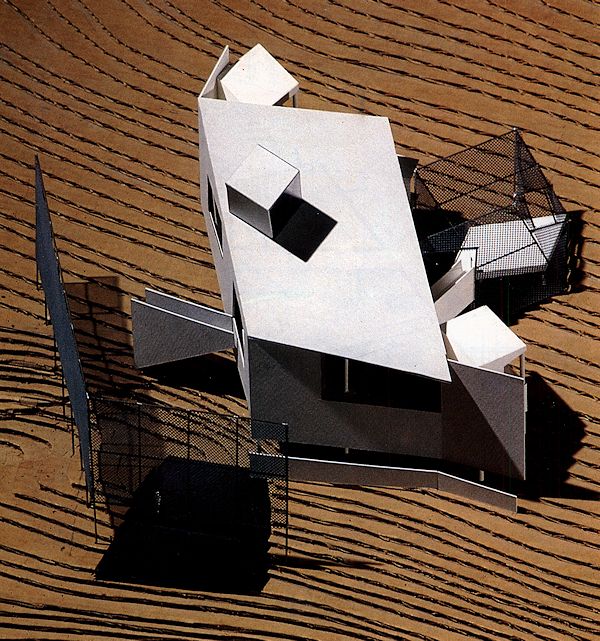House of Otto 4 2310
Domestic Museum 2381
dossier: Gehry 3247
| |
1996.01.10
scale and architecture
...raised box: Villa Savoye, Wagner House, Bye House, House in Laguna...
1998.08.04
distortion of plans
...playing with the Bye House and the Wagner House plans. It began with uneven scale/rotation distortion, and then began to see dramatic results by simply moving various parts of the plan... ...whole new building plans emerged. My next step is to perform these manipulations on the 3d models. I'm sure the results will be very promising.
These manipulative operations, which are extremely easy with CAD, raise some issues, e.g., copyright, integrity of the secondary designer, as well as pushing the envelope of acceptable design practice. In the realm of theory, however, this exercise initiates a totally new type of design methodology--one that stems almost purely from the benefits of cyberspace. ...continue experimenting... ...the opportunity to create a vast amount of completely new buildings, which in turn may become whole new virtual environments. ...Towards a New Dexterity... ...the makings of some revolutionary architecture[?]... ...that involves theory and practice.
2008.05.29 09:27
Can you say canonical?
Moretti: Casa del Girasole (Eisenman)
Mies: Seagrams (Eisenman)
Le Corbusier: Palais des Congrès (me)
Le Corbusier: Olivetti Center Milan (me)
Kahn: Dominican Sisters Convent (me)
Venturi & Rauch: Franklin Court (me)
Stirling: Leicester Engineering (Eisenman, "Real and English")
Stirling: Nordrhine/Westfalen Museum (me)
Stirling: Wallraf-Richartz Museum (me)
Rossi: Modena Cemetery (Eisenman)
Koolhaas: Patent Office (me)
Libeskind: who cares (me)
Gehry: Wagner Residence and other residences of that era (me, just to be a bit obscure)
| |
2011.12.06 21:36
Frank Gehry
pliant 1 : yielding readily without breaking : bending or folding easily
About a month ago, I purchased Constructing a New Agenda: Architectural Theory 1993-2009. The first essay in the book is "Architectural Curvilinearity: The Folded, the Pliant, and the Supple" (1993) by Greg Lynn. Upon seeing this title I immediately thought of the post above. I have little doubt that it was a long ago reading of this essay (as I used to own several books by Lynn, although now all sold off at eBay about 8 years ago) that lodged the connection of Gehry's architecture and pliancy somewhere in my brain. With the 2008 post, however, I was thinking more along the lines of the pliancy demonstrated by the plan of Gehry's Wagner House (1978) and the 3-dimensional execution of this plan as well.
2011.12.07 12:24
Frank Gehry
...you are correct, I do not mean "pliability/pliancy only in literal surface-curving manner," but more of a "yielding readily" (like the varying aspects of the plan of the Wagner House which is on a sloped site). Perhaps it is uncannily (or even appropriately) ironic that the Venturi and Rauch peeling wall detail yields from an actual bending wall.
I (re)read about 75% of Lynn's essay last night, and there one sees "the pliant" more in the sense of literal bending and folding, plus also more in concert with suppleness and smoothness--although here too Gehry's architecture is most often used as example. (I feel my reading last night suffered a bit due to no illustrations accompanying this latest version of the essay.)
...the pliancy of the Palace of Ottopia is more a demonstration of the drawing pliancy that "laissez-faire" CAD manipulation allows. Yes, the Danteum is there, but so is Hejduk's Bye House, a bit of Perruzzi's Palazzo Massimo and a little bit of myself. Also, the gemmating Danteum plans allude to Eisenman (Aronoff).
Interestingly, within the studies for the palace of Ottopia (010808a.db) there are some (pliant CAD) manipulations of Gehry's Wagner House--which eventually became House for Otto 4.
| |

|